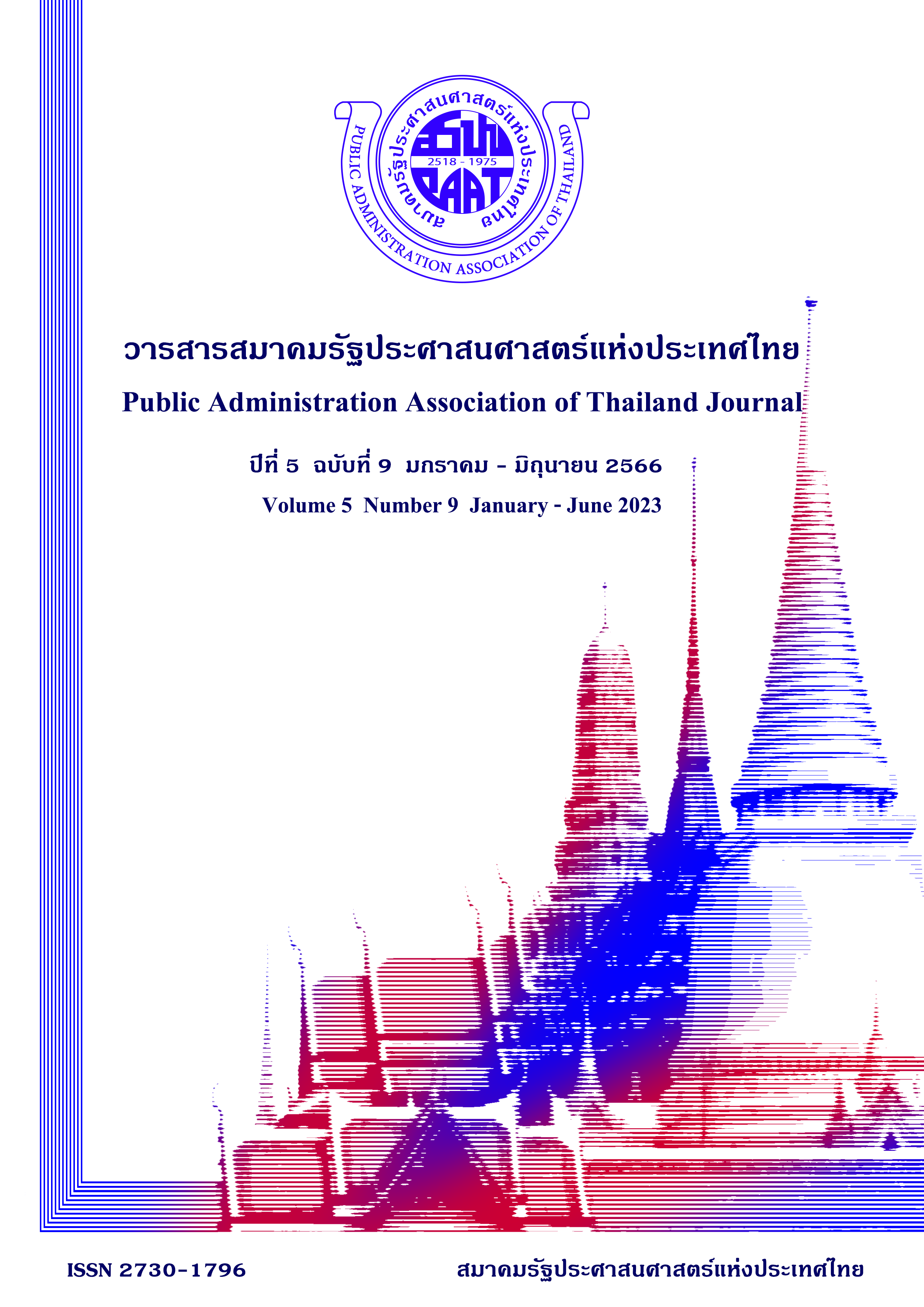การสร้างเมืองที่เป็นมิตรต่อผู้สูงอายุ: โจทย์การบริหารจัดการท้องถิ่นในศตวรรษที่ 21
คำสำคัญ:
ผู้สูงอายุ, เมืองที่เป็นมิตรต่อผู้สูงอายุ, การบริหารจัดการท้องถิ่นบทคัดย่อ
แนวคิดของเมืองที่เป็นมิตรต่อผู้สูงอายุกำลังได้รับแรงผลักดันในศตวรรษที่ 21 เนื่องจากมีการคาดการณ์ว่าประชากรผู้สูงอายุทั่วโลกจะเพิ่มขนาดเป็นสองเท่าภายในปี ค.ศ. 2050 (United Nations Development Programme, 2023) อย่างไรก็ตาม การพัฒนาเมืองเหล่านี้ต้องเผชิญกับอุปสรรคหลายประการในการปกครองท้องถิ่น ไม่ว่าจะเป็นข้อจำกัดของเงินทุน การไม่ยอมรับการเปลี่ยนแปลงของภาคส่วนต่าง ๆ ความไม่เพียงพอของข้อมูลและงานวิจัยที่เกี่ยวข้องกับความต้องการของผู้สูงอายุ ข้อจำกัดด้านการมีส่วนร่วมของผู้สูงอายุ และการขาดความร่วมมือระหว่างรุ่น เพื่อการพัฒนาเมืองที่มองเห็นความต้องการของผู้สูงอายุ รัฐบาลท้องถิ่นต้องเอาชนะความท้าทายเหล่านี้โดยการจัดลำดับความสำคัญของปัญหาและให้ความสำคัญกับการพัฒนารายได้ท้องถิ่น การมีส่วนร่วมของผู้สูงอายุ การส่งเสริมการวิจัยและพัฒนาองค์ความรู้ด้านผู้สูงอายุ และส่งเสริมความร่วมมือระหว่างรุ่น บทความวิชาการนี้นำเสนอข้อมูลภายใต้ฐานของการศึกษาวิจัย เพื่อสำรวจความท้าทายในการพัฒนาเมืองที่เป็นมิตรต่อผู้สูงวัยในศตวรรษที่ 21 ตลอดจนนำเสนอความสำคัญของการจัดการปัญหาเหล่านี้ผ่านการบริหารจัดการท้องถิ่นเพื่อเพิ่มประสิทธิภาพในการพัฒนาเมืองหรือท้องถิ่นให้สร้างความเป็นอยู่ที่ดีให้แก่ประชากรผู้สูงอายุ
References
Bradley, D. E., & Longino, C. F. (2001). How Older People Think About Images of Aging in Advertising and the Media. Generations: Journal of the American Society on Aging, 25(3), 17-21.
Kokpol, Orathai. (2016). Urbanization: When “city” Becomes a Problem of Local Management Modern. Bangkok: King Prajadhipok’s Institute. [In Thai]
Ladbuakhao, S. (2020). Local Finance: Problems and Solutions. Political Science and Public Administration Journal, 11(1), 189-214.
Madrid, I. I. (2002). Thailand Implementation of the Madrid International plan of action on ageing (MIPAA) 2002-2016. New York: United Nations, 2417.
Ministry of Social Development and Human Security and the Ministry of Public Health. (2021). The Plan of Action for Long-term Elderly Care, 2021.
OECD. (2015). Ageing in Cities. OECD. Retrieved February 24, 2023, from http://dx.doi.org/10.1787/9789264231160-en.
Phrompayak, D. and Wanchai, A. (2019). A Systematic Review of Factors Influencing Social Participation of Older Adults. Pacific Rim International Journal of Nursing Research, 23(2), 131–141.
Reese C. Wilson (1976). Urban priority 1: Increased local government effectiveness – JSTOR.ORG. (n.d.). Retrieved February 20, 2023, from https://www.jstor.org/stable/pdf/3379955.pdf
Ruangkiatkul, N. (2022). Factors Associated with Health Literacy among Thai older adults. Journal of the Department of Medical Services, 47(1), 80-86.
Sumalee, E. and Tanchai, C. (2019). Smart city Smart city: basic concepts and operating systems for digital cities. King Prajadhipok's Institute First printing. [In Thai]
Steels, S. (2015). Key characteristics of age-friendly cities and communities: a review. Cities. ISSN 0264-2751.https://doi.org/10.1016/j.cities.2015.02.004
Thang, L. L. (2011). Family policy: Promoting intergenerational understanding between the young and old: the case of Singapore. Retrieved February 26, 2023, from https://www.un.org/esa/socdev/family/docs/egm11/Bogenschneider-paper.pdf
The Cross National Data Center in Luxembourg. (2018). Luxembourg Income Study Database (LIS) and the Luxembourg Wealth Study Database (LWS). LIS cross-national data center in Luxembourg. Retrieved February 28, 2023, from https://www.lisdatacenter.org/
United Nations. (2018). Ageing related policies and priorities in the implementation of the 2030 Agenda for Sustainable Development. Retrieved February 26, 2023, from https://www.un.org/development/desa/ageing/wp-content/uploads/sites/24/2019/07/Analysis-Ageing_VNRs_Final28122018.pdf
United Nations. (2020). 68% of the world population proected to live in urban areas by 2050, UN Desa Department of Economic and Social Affairs. United Nations. Retrieved February 28, 2023, from https://www.un.org/development/desa/en/news/population/2018-revision-of-world-urbanization-prospects.html
United Nations. (2022). World Population Prospects 2022, Online Edition. Chapter one. New York: United Nations.
United Nations Development Programme. (2023). World Social Report 2023: Leaving No One Behind – Ageing World. Retrieved from https://desapublications.un.org/publications/world-social-report-2023-leaving-no-one-behind-ageing-world
U.S. Department of Health and Human Services. (2023). Aging in place: Growing older at home. National Institute on Aging. Retrieved February 21, 2023, from https://www.nia.nih.gov/health/aging-place-growing-older-home
Weerasak K. (2004) Local Government Initiatives in Thailand: Cases and Lessons Learned. Asia Pacific Journal of Public Administration, 26(2), 217-239,
World Economic Forum. (2022). Accelerating Urban Inclusion for a Just Recovery (Ser. Insight Report, pp. 19–21). Geneva, Switzerland: World Economic Forum.
World Economic Forum. (2022). Accelerating Urban Inclusion for a Just Recovery (Ser. Insight Report, pp. 22). Geneva, Switzerland: World Economic Forum.
World Health Organization. (2007). Global age-friendly cities: A guide. World Health Organization.
World Health Organization. (2016). Creating Age-friendly Environments in Europe: A Tool for Local Policy-makers and Planners. Retrieved February 23, 2023, from https://apps.who.int/iris/bitstream/handle/10665/334252/9789289052122-eng.pdf
World Health Organization. (2017). Integrated care for older people: guidelines on community-level interventions to manage declines in intrinsic capacity. Retrieved February 26, 2023, from https://www.who.int/publications/i/item/9789241550109
World Health Organization. (2018). The Global Network for Age-friendly Cities and Communities: Looking back over the last decade looking forward to the next. Retrieved February 24, 2023, from https://www.who.int/activities/creating-age-friendly-cities-and-communities
Downloads
เผยแพร่แล้ว
How to Cite
ฉบับ
บท
License
Copyright (c) 2023 วารสารสมาคมรัฐประศาสนศาสตร์แห่งประเทศไทย

This work is licensed under a Creative Commons Attribution-NonCommercial-NoDerivatives 4.0 International License.


